Internal server error is one of the most common WordPress errors. Sometimes when we open a web page, we will see the page prompts500 Internal server error! So, what the hell is this? And how do we fix it? Let's take a look down the road!
![Image[1]-How to Fix 500 Internal Server Error in WordPress - Photon Flux | Professional WordPress Repair Service, Global Reach, Fast Response](https://www.361sale.com/wp-content/uploads/2024/08/2024080503085831.png)
500 What is the internal server error?
500 Internal Server Error is a common web server error. It is not unique to WordPress and can happen to any website.
The 500 in the error message is technically an HTTP error code. Finding this code only displays its standard description:
" 500 An internal server error response code indicates that the server encountered an unexpected situation that prevented it from completing the request. "
This is a generic catch-all error message, which means that the server can't provide a better, more useful error message when it encounters a problem.
The appearance of the error page will vary, depending on the web server software used for the site (Nginx or Apache) and the browser used.
The Apache error page is generally shown below:
If you use theNginxrespond in singing Google ChromeIt'll be different.
If Google Chrome can't find the error page to display, this is what it usually says:
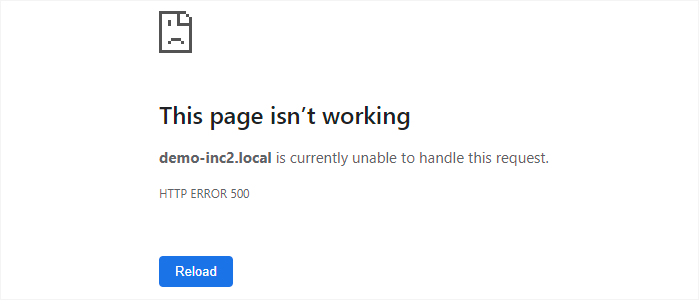
For newbies, this is more of a headache. There is no information to guide them to fix this problem.
However, if one knows the common reasons that trigger this error, then one can try to fix them one by one to resolve the error without breaking anything inside the website.
What causes WordPress to get internal server errors?
Internal server errors in WordPress are usually caused by theCorrupt .htaccess files,Plugins with questionable codingmaybe WordPress ThemesCause.
Other possible causes of WordPress internal server errors are PHP memory limitations or corrupted core WordPress files.
In some cases, when trying toAccessing the WordPress Admin AreaThe internal server error occurs only when the rest of the site is working fine.
Usually, this error is triggered before WordPress loads and the server can't get enough information about the reason for the stop.
Now let's see how to fix internal server errors in WordPress.
Fix 500 Internal Server Error in WordPress
Oh, my God! The caveat is back. As always, make sure you have a full WordPress data backup of your website before you start troubleshooting.
If you have access to the WordPress admin area, then you can use theWordPress Backup Pluginto create a full backup of the site or go to the server for a backup as well.
To use a plugin, we recommend using theDuplicatorto deal with this problem. Not only does it help in backing up the website quickly, but it also stores the backup in the cloud and most importantly, restores the website from the backup quickly.
On the other hand, if you don't have access to the WordPress admin area, you can use the phpMyAdmin respond in singing FTP clientCreate WordPress backups manually.
After that, you can follow the steps below to troubleshoot and fix internal server errors on your website.
Clear WordPress and Browser Cache
Browsers and WordPress cache plugins sometimes incorrectly store cached copies of error pages.
The easiest way to fix this problem is to clear your browser cache first.

After that, if you have access to the WordPress admin area of your website, then you can empty the WordPress cache by visiting the settings page of the caching plugin.
Checking for corrupt .htaccess files
The .htaccess file is a server configuration file that WordPress also uses to set up redirects.
One of the most common causes of internal server errors is a corrupt .htaccess file.
The easiest way to resolve this issue is to visit the WordPress admin area in the"Set "Fixed Link""page, and then click "Save Changes" button without making any other changes.
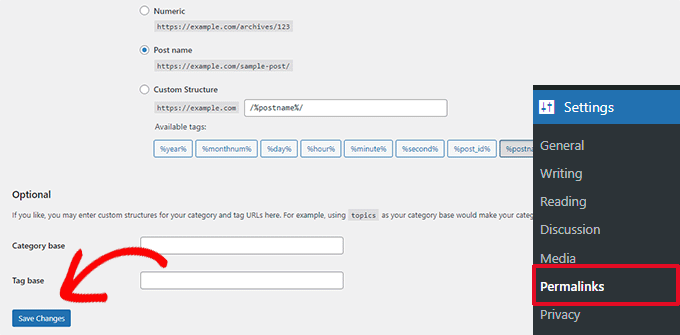
WordPress will now try to update the .htaccess file or generate a new one. You can now visit the site to see if this resolves the internal server error.
If you still see the error, you need to make sure that WordPress is able to generate or write .htaccess files.
Sometimes, WordPress may not be able to create or write .htaccess files due to file and directory permissions.
Now you can try to replace the .htaccess file manually. First, you need to log in to the site using FTP's File Manager application.
Next, the main .htaccess file needs to be renamed to something like .htaccess_old. This will keep the file as a backup, but WordPress will not recognize it.
To rename the .htaccess file, you need to log in to the site using FTP's File Manager application.
Once connected, the .htaccess files will be located in the same directory where you will see the folders wp-content, wp-admin and wp-includes.
Simply right-click on the .htaccess file and rename it to .htaccess_old.

Next, a new .htaccess file needs to be created.
In the root folder of the site, right-click and then in the FTP client or file manager application select "Creating a new file"Options.
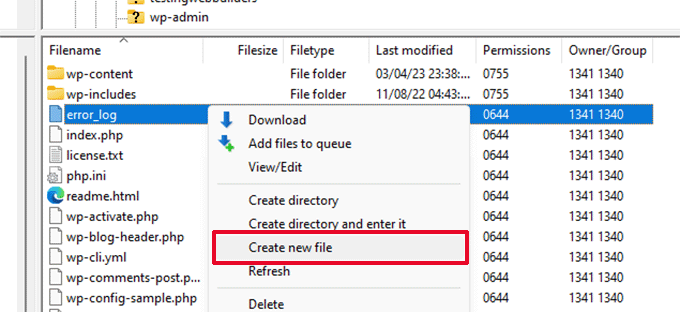
Name this new file .htaccess and click "recognize"Saving.
Now, thisThe .htaccess file is currently emptyYou will need to add the default WordPress rewrite rules to it.
Simply right-click on the file and then in the FTP client or file manager application select "View/Edit"Just do it.
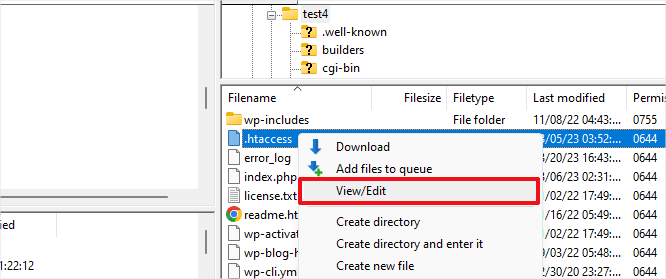
Empty files will be opened in a plain text editor such as Notepad or TextEdit.
Now, the following code needs to be copied and pasted:
![Image [9] - How to Fix 500 Internal Server Error in WordPress - Photonflux.com | Professional WordPress Repair Service, Worldwide, Fast Response](https://www.361sale.com/wp-content/uploads/2024/08/2024080502270788.png)
This code is the default ruleset used by WordPress.Don't forget to save the changes and upload the file back to the server!The
You can now visit the website to see if this resolves the internal server error.
Important Tip:Before proceeding further, be sure to go to the WordPress admin area in the"Settings" ""Fixed links""page, and then click "save (a file etc) (computing)" button without making any changes. This will regenerate the .htaccess file with the appropriate rewrite rules to ensure that the post page does not return the404 ErrorThe
If checking for corrupt .htaccess file solution doesn't work, then try something else.
Increase PHP memory limit
Sometimes an internal server error occurs if the script consumes all of the PHP memory limit.
The easiest way to increase the PHP memory limit is to edit the wp-config.php file. If you are a novice, do this carefully. These instructions need to be followed carefully as a small error in a WordPress core file can cause your site to crash.
First, simply connect to the WordPress site using the FTP client's File Manager application.
The wp-config.php file will be found in the main website folder. Right-click on it and select "downloading". This ensures that there is a backup of your files in case something goes wrong.
Once saved, you can right-click on it and select "View/Edit".

In the wp-config.php file, you need to add the following code above the "That's all, stop editing! Happy publishing" line:
define( 'WP_MEMORY_LIMIT', '256M' );Attention:If 256M does not solve the problem, you can increase it to 512M.
If you see an internal server error when logging into the WordPress admin backend or uploading an image in wp-admin, you should follow these steps to increase the memory limit:
- Create a blank text file on your computer and name it php.ini
- Paste this code into it: memory=256MB
- Save file
- Upload it to your /wp-admin/ folder.
If increasing the memory limit solves the problem, then it will only solve the problem temporarily. It is still necessary to find the cause of exhausting the memory limit.
It could be a poorly coded plugin, or it could be a theme feature.
If increasing the PHP memory limit does not solve the problem, more troubleshooting is required.
Disable all WordPress plugins
If none of the above solutions are suitable, then this error is most likely caused by the websiteSpecific plug-ins installedCause.
It is also possible that this is due to plugin combinations not working well with each other.
If you have access to the WordPress admin area of your website, then you can go directly to the Plugins page and deactivate all WordPress plugins.

However, if you cannot access the WordPress admin area, then you can disable all WordPress plugins using FTP.
Simply connect to the WordPress site using the FTP client's File Manager application.
Once connected, navigate to the /wp-content/ folderand rename the plugin folder to plugins.deactivatedThe
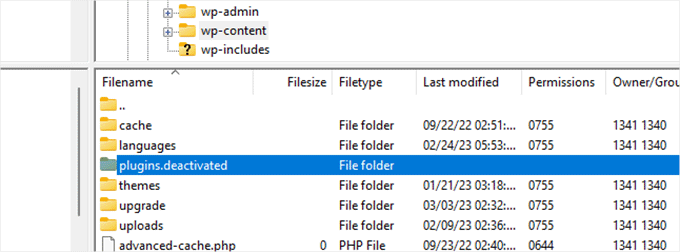
WordPress looks for plugins in the plugin folder. If the plugin folder is not found, it will automatically deactivate all plugins.
Now try visiting the website and see if this resolves the internal server error on the site.
To restore all plug-ins, simply set the "plugins.deactivated"Folder renamed to pluginReady to go.
The plugin will now be restored, but will still be deactivated.
You can now activate the plugins individually and refresh the front end of the site to find out which plugin is causing the internal server error.
If deactivating all plugins doesn't fix the internal server error on your site, move on to the next method.
Switch to the default WordPress theme
Internal server errors can also be some code in WordPress themes.
To determine if this is the case, you need to switch the theme to the default WordPress ThemesThe
Visit the WordPress admin backend and go toAppearance " ThemesPage. If the default theme is installed, simply click the Activate button to switch themes.
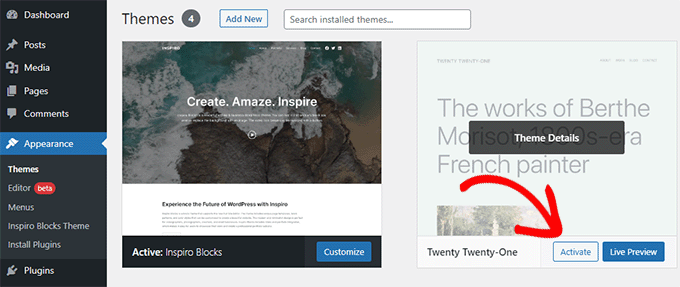
If the default theme is not installed, you can click on the top "Add New" button and install the default theme (Twenty Twenty-Twenty-Three, Twenty Twenty Twenty-Two, etc.).
If you cannot access the WordPress admin area, use an FTP client to connect to the WordPress website and navigate to the /wp-content/ folder.
Right-click to select the Themes folder and download it to your desktop as a backup.
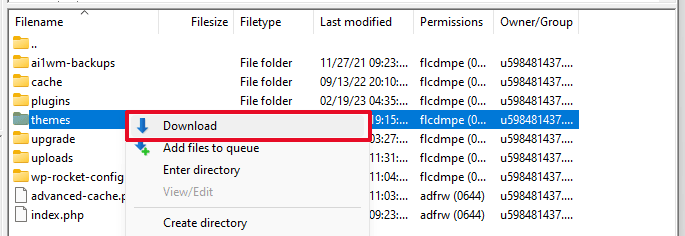
Next, the theme folder needs to be deleted from the site. After deleting it, go ahead and create aNew theme folderThe
The new theme folder will be completely empty, which means that no WordPress theme is currently installed.
Next, you need to visit the WordPress theme directory and download the default WordPress theme to your desktop.

The browser will then download the theme as a zip file to your desktop.
Locate the file on your computer and unzip it.Windows users can unzip the file by right-clicking on the file and selecting "Full extraction"Mac users can double-click the zip file to extract it.
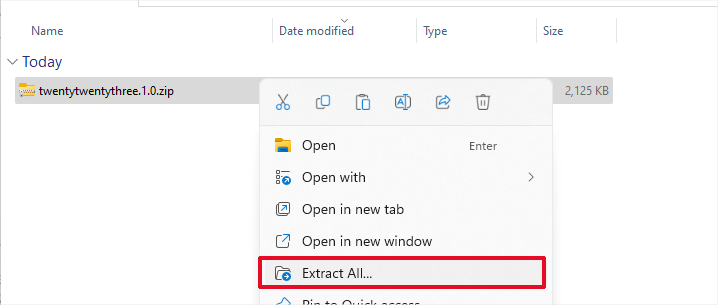
You will now see a folder containing WordPress themes.
Switch back to your FTP client or file manager and upload this folder to an empty topic folder.
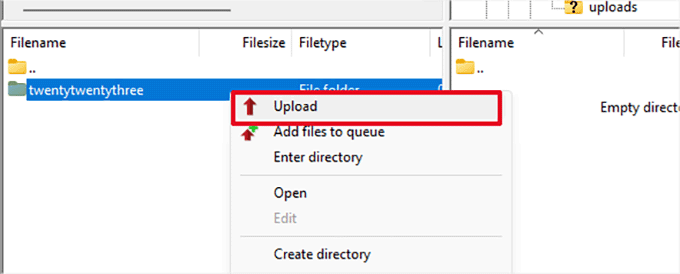
Once uploaded, WordPress will automatically start using the default theme.
You can now visit your site and see if this resolves the internal server error.
If that doesn't work, then you can either re-upload the WordPress theme from a backup or switch back to the theme you're using.
Re-uploading of core files
If the plugin and theme options don't fix the internal server error, it's worth re-uploading the /wp-admin/ and /wp-includes/ folders from a fresh WordPress installation.
This won't delete any information, but it may fix the problem if there are corrupted files.
First, you need to visit the WordPress.org website and click "Download "Button.
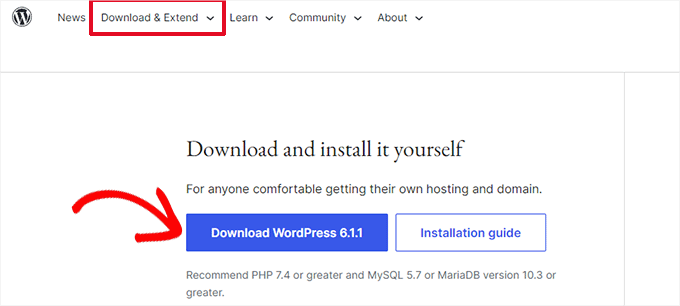
This will download the WordPress zip file to your desktop.
Go ahead and extract the zip file. Inside, you will find a wordpress folder.

Next, you need to connect to your WordPress site using an FTP client.
After connecting, go to the root folder of the site. This folder contains wp-admin, wp-includes respond in singing wp-content folderThe
In the left column, open the WordPress folder on your computer.
Now you need to select all the files in your wordpress folder and upload them to your website.
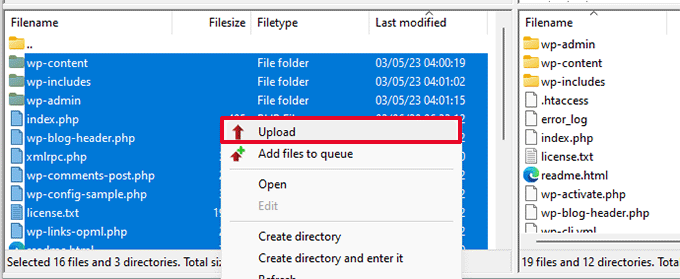
The FTP client will now transfer these folders to the server.
It will ask if you want to overwrite the file. Select "overwrite", then select "Always use this action"and check the box."Only for the current queue"Checkbox.

The FTP client will now replace the old WordPress files with the new ones.
If the WordPress files are corrupted, then this step fixes the internal server error.
Enabling Debug Logging in WordPress
WordPress comes with a built-in system to keep debugging logs.
It can be enabled using the WP Debugging plugin.
Once activated, the plugin opens the debug log on the WordPress website.
If you can't access the admin area of your WordPress site, you can enable debugging by adding the following code to the wp-config.php file:
define( 'WP_DEBUG', true);
define( 'WP_DEBUG_LOG', true); After opening the debug log, you can use the FTP client and navigate to the /wp-content/ folderto view these logs.
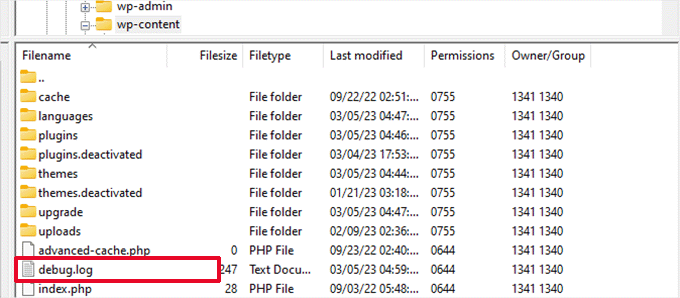
A debug log file can be opened in a text editor, which will display a list of errors and warnings that have occurred on the site.
Some errors and warnings may be fine and may not need to be fixed. However, if internal server errors are seen on the site, then these may give some indication.
Link to this article:https://www.361sale.com/en/15545
The article is copyrighted and must be reproduced with attribution.





























No comments